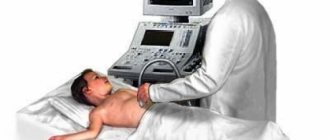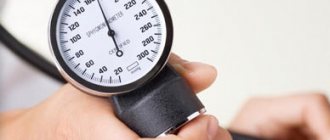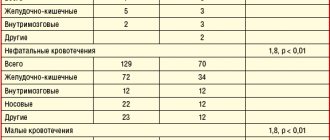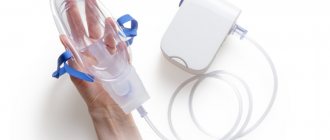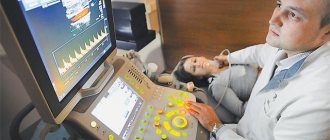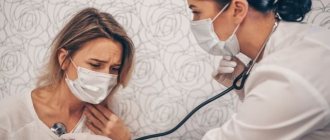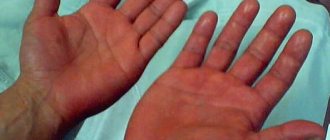Saturation (English saturation - “saturation”) of blood with oxygen shows how much of this vital gas for organs is currently contained and circulating in the blood. The indicator is expressed as a percentage. Low saturation, including during coronavirus, indicates hypoxemia, which requires urgent action. It is necessary to increase the level of oxygen in the lungs and blood to prevent complications and sometimes to save the patient's life.
Blood oxygen saturation is measured with a special device - a pulse oximeter. With the help of this express analysis, emergency doctors can obtain objective information about the state of the patient’s respiratory and circulatory system, as well as quickly make a decision on hospitalization and oxygen support. It is not always possible to quickly perform a CT scan of the lungs. If a patient’s saturation is clearly reduced during COVID-19, this most likely indicates a viral infection of the lungs—pneumonia.
Measuring blood oxygen saturation with a pulse oximeter device allows emergency teams to identify seriously ill patients with likely extensive lung damage caused by COVID-19, and also quickly make decisions about hospitalization and the necessary additional oxygen support.
If a patient with coronavirus has such a device at home, then he can carry out monitoring on his own, however, it is important to understand that pulse oximetry (measurement of saturation) does not replace a visual assessment of the condition of the lungs (CT of the lungs), and an incorrect interpretation of this indicator can only frighten the patient and mislead ambulance or cost the patient his life.
A patient with a new coronavirus infection and doctors should not focus solely on the saturation indicator - the measurement result highly depends on a number of third-party factors: the sensitivity of the device, lighting, and the color of the patient’s skin. Meanwhile, if you rely on this indicator as the main one (without spirometry and CT), there is a high probability of an inadequate assessment of a person’s health - in severe pneumonia, the saturation may remain normal for some time, and then drop sharply. At night, saturation decreases even in a healthy person.
In this material we will examine the main issues related to saturation during coronavirus.
What is saturation?
Saturation is an indicator of the saturation of blood with oxygen, which comes from the pulmonary alveoli. Together with blood, oxygen is transported to organs and tissues. A decrease in saturation during COVID-19 indicates hypoxemia, the likely cause of which is viral infection of the lungs. The hypothesis can be confirmed or refuted by computed tomography - during a visual assessment of the lungs.
Standard indicators
Advertising:
In the course of numerous studies, scientists have concluded that the saturation level in adults should be 95-100%. At the same time, there is no dependence on a person’s gender or age. A decrease in levels to 94% or lower is an alarming signal, which is an indication for medical intervention. Detailed information about standard indicators is presented in the table.
| Degree | Pulse oximetry readings |
| norm | more than or equal to 95% |
| 1st degree | 90-94% |
| 2nd degree | 75-89% |
| 3rd degree | less than 75% |
| hypoxemic coma | less than 60% |
A decrease in saturation may be a variant of the norm, for example, in smokers. For people suffering from this addiction, values are set at 92-95%. Smoking disrupts the transport of gases by hemoglobin, leading to regular minor hypoxia of cells. Voluntary poisoning reduces the oxygen level in red blood cells. Over time, this leads to various pathologies in the internal organs.
What is the normal saturation level for a healthy person?
The norm for a healthy person is SpO2 = 95-99 (or 100)%. The rate of blood oxygen saturation depends on the individual characteristics of the human body, for example, on the presence or absence of anemia, apnea, chronic diseases of the respiratory and cardiovascular systems, bad habits, and age. At night, each person's saturation decreases, and the differences can be significant. For example, in people with chronic diseases of the respiratory system (COPD, apnea), who have adapted to a constant lack of oxygen, the rate can drop to 90% (in the deep sleep phase).*
According to the observations of doctors working in hospitals with seriously ill patients who are on oxygen, the most dangerous time is from 3 to 7 am. At this time, the largest number of deaths are recorded due to decreased saturation, or more precisely due to oxygen hypoxemia.
RE Gries, LJ Brooks, Normal oxyhemoglobin saturation during sleep. How low does it go? K. Szabó, F. Ihász, The effect of reduced oxygen saturation during sleep on depression, 2020
Why does saturation decrease during coronavirus?
Not all patients with COVID-19 have a decrease in saturation, but only with the development of a complication - viral pneumonia. A decrease in saturation indicates probable respiratory failure. If a coronavirus infection has penetrated the lung tissue, and a person’s immune system cannot cope with it, a destructive process begins in the lungs - the alveolar septa (and interstitium) are damaged and inflamed, and the alveoli themselves are filled with liquid exudate - normally they are filled with air and are the starting point of transportation oxygen to organs, including the heart and brain. Since there is no damage to the bronchial tree with coronavirus, a decrease in saturation in a patient may indicate a reduction in the functional areas of the lung tissue.
If coronavirus saturation is below 95%, the patient may be hospitalized.
Pulse oximeter for diagnosing coronavirus
Symptoms of an actual illness can easily be confused with a common cold. However, due to the epidemic of infection, mass diagnosis has certain difficulties, so many people began to purchase pulse oximeters in order to detect the presence of the disease in time.
For example, in the United States, those with mild coronavirus cases are sent home for treatment and given pulse oximeters. Monitoring your condition is important to avoid rapidly developing complications that can be fatal.
Important! When infected with coronavirus, the saturation will show 93% or lower.
Why measure saturation during coronavirus?
Coronavirus saturation is measured to quickly detect life-threatening hypoxemia. In this way, the severity of the disease is determined and a decision is made on further actions: hospitalization, oxygen support, computed tomography.
In foreign literature there is the term “silent hypoxemia”, which appeared only recently, during the COVID-19 pandemic, when it became clear that a fairly large percentage of patients were admitted to the hospital with an acute lack of oxygen, disproportionate to the symptoms. It turns out that patients can breathe, do not choke, there is no strong cough and no fever, while the lungs are severely damaged, saturation is critically low, and additional oxygen is needed.
Can a patient with symptoms of coronavirus somehow suspect that he has a lack of oxygen due to pneumonia? Yes.
Symptoms of decreased saturation
- Try holding your breath for a few seconds - if you can't help but breathe as long as before, and this action is causing difficulty, it makes sense to measure your saturation.
- Your breathing and heart rate have increased.
- The skin turned pale and acquired a bluish tint (face, lips, fingertips).
- You feel very tired and sleepy.
- My head hurts and feels dizzy, I have problems with memory and concentration.
- You are experiencing some symptoms of a respiratory system disease: shortness of breath, discomfort and unusual sensations in the chest, coughing.
Symptoms of Covid-19
The content of the article:
- Symptoms and course of Covid 19 in adults
- ARVI and coronavirus
- Features of clinical manifestations of coronavirus in children and symptoms in pregnant women
- Saturation as an important indicator of coronavirus infection
Symptoms and course of Covid 19 in adults
Covid 19 is a disease that has caused one of the longest pandemics in the world. This term is usually understood as the name of the virus, however, this is not so. The pathogen itself is called SARS-CoV-2 and it is it that penetrates the human body, causing a dangerous disease.
Coronaviruses are a fairly well-known group of viruses that can cause an infectious process. The first serotypes were identified back in the 60s; over time they only mutated. However, one thing remained unchanged, the method of infection. The virus itself looks like a ball with teeth all over its entire area, hence its name “crown”. A viral particle invades a human cell, changes its mechanism of operation, and then reproduces many copies of itself. The immune system cannot recognize all of these mechanisms.
Of course, such a disease could not help but change, and today the following forms of coronavirus are distinguished: alpha (British), beta (South African), gamma (Brazilian) and delta (Indian). As scientists note, each new strain of the virus may be more aggressive than the previous one. Another important detail is that different strains have a greater impact on certain groups of people, for example, young people under 40 years of age are more likely to get sick with the betavirus, while pregnant women and young people are more susceptible to the gamma strain. With the latest delta strain, there is no official information yet on who is more susceptible to infection, but it is known that this type is spreading at an incredibly fast pace. According to the open Russian consortium for sequencing the genomes of SARS-CoV-2, it was the delta strain that caused the disease in more than 90% of those infected with Covid in July 2021. So far, all produced vaccines are effective against the identified strains.
What symptoms of coronavirus occur in a sick person and how to distinguish them from a regular ARVI, we will analyze in the article.
Stages of the disease:
- From 1 to 3 days. A person feels the first signs of coronavirus, experiences muscle discomfort and weakness. Body temperature can reach subfebrile levels of 37-37.5 degrees. Possible nasal congestion. The general condition is similar to the onset of a common ARVI.
- From 3 to 5 days. During this period, the virus manifests itself as a mild cough. Many sick people lose their sense of smell, they stop feeling the taste of food, or it changes. More than half of the sick experience mild abdominal pain and diarrhea during this period. Body temperature continues to rise.
- From 5 to 10 days. During this period, patients whose immune system was able to cope with the virus begin to recover. The symptoms gradually disappear. Otherwise, especially against the background of chronic diseases, the symptoms not only do not go away, but also intensify. There is a strong barking cough, chest pain, runny nose, shortness of breath, tachycardia.
- From 10 to 13 days. During this period, the disease progresses greatly. Chest pain intensifies, breathing becomes rapid, the skin becomes pale. Blood oxygen levels can drop to critical levels, which is why it is so important to constantly measure them. Lung damage is diagnosed from 20 to 60%. The patient requires hospitalization.
- From 13 to 15 days. During this period of time, two options are possible: the further course of the disease is pneumonia, which requires artificial ventilation, or recovery with properly selected treatment.
- From 15 to 30 days. During the recovery process, even with significant improvement in the condition, shortness of breath continues to persist. Smell and taste may not return for a long time. The norm is taken to be from one month to six months.
Currently, various clinical variants of the course and manifestations of coronavirus in humans have been recorded, including the following:
- pneumonia with acute respiratory failure;
- pneumonia without respiratory failure;
- damage to the upper respiratory tract;
- septic shock;
- thrombosis, blood clotting disorder.
Symptoms of coronavirus can vary depending on the severity of the disease: mild, moderate, severe.
The mild form implies the following symptoms:
- increase in body temperature to subfebrile levels;
- dry cough with almost no discharge;
- weakness in the body.
Less common, but also possible, are the following:
- loss of taste and smell;
- nasal congestion;
- sore throat;
- headache, migraine;
- conjunctivitis;
- diarrhea;
- skin rash.
The symptoms are similar to the onset of a standard respiratory illness, except for the loss of smell and taste.
Severe disease involves symptoms such as:
- dyspnea;
- severe cough with discharge, possibly blood;
- loss of appetite;
- severe chest pain;
- high temperature, 38 degrees or more;
- feverish state, loss of consciousness;
- a sharp drop in blood oxygen levels according to pulse oximetry.
Less common, but also possible:
- irritability, anxiety;
- convulsions;
- tachycardia;
- severe vitamin D deficiency.
In older people, the disease may have an atypical course, including various neurological disorders.
It should also be remembered that after infection with coronavirus, chronic diseases of the heart, kidneys, and gastrointestinal tract often become more active, which means consequences such as stroke, ischemia, etc. are possible.
Attention! Symptoms may not fully manifest themselves; for example, cases of coronavirus without fever are not uncommon. Even more often, there are no symptoms at all, and the person experiences Covid in a very mild form, believing that he has a runny nose for 2-3 days.
ARVI and coronavirus
The coronavirus spread so quickly partly because it was impossible to diagnose it correctly right away. Covid, unlike ARVI, can lead to more serious complications, so you need to learn to distinguish between the symptoms of a common cold and coronavirus.
Similar symptoms:
- cough;
- runny nose;
- a sore throat;
- elevated body temperature.
The difference between coronavirus and ARVI:
- long incubation period. ARVI develops rapidly, while Covid-19 enters the acute phase only after 2 weeks.
- low-grade fever that lasts up to a week. While with ARVI, the temperature rises to febrile levels already on the 2-3rd day.
- Cough with coronavirus is prolonged, often dry, barking, accompanied by pain in the sternum. With ARVI, the cough becomes productive with sputum discharge.
- During Covid, diarrhea and vomiting are often observed, while with ARVI such signs are absent, unless the respiratory disease is accompanied by poisoning.
What is the difference between coronavirus and flu
Common features of influenza and coronavirus:
- chills, body aches, general state of weakness;
- diarrhea;
- Influenza is also transmitted by contact and airborne droplets.
Main differences:
- unlike coronavirus, the flu develops rapidly, body temperature rises to 39-40 degrees;
- the patient feels a headache, pain in the eyes, and may experience light and sound sensitivity.
Features of clinical manifestations of coronavirus in children and symptoms in pregnant women
The total percentage of children infected with coronavirus in the world is about 10%; in Russia this figure is 6-7% of the total number of cases.
For the most part, children tolerate coronavirus much easier, often without even realizing they are infected, since there are no obvious symptoms. But there are often severe and moderate cases when babies need hospitalization.
More often, children become infected with Covid from sick adults.
Characteristic symptoms of the disease in children:
- fever;
- dry cough without discharge;
- nausea and vomiting;
- scratchy sore throat;
- diarrhea.
Children, just like adults, may lose their sense of smell and taste, but most often they do not attach any importance to this and do not experience severe discomfort.
A characteristic visual sign of coronavirus for children is blue-white fingers that appear to be frozen.
In children, as in adults, a practically asymptomatic course of coronavirus is possible, which means that any changes can only be observed on a computed tomogram (characteristic lung lesions are visible).
Symptoms of Covid in pregnant women
Pregnant women are at greater risk of contracting coronavirus because their immune system is less active while pregnant.
Their signs of infection are the same as for other people:
- headache, muscle pain;
- fatigue;
- loss of smell and taste;
- slight increase in temperature.
However, symptoms that are characteristic only of pregnant women and threaten the life and health of the mother and child may also occur:
- high blood pressure;
- severe swelling;
- abdominal pain;
- bleeding;
- a sharp drop in saturation.
Any of the above symptoms requires urgent hospitalization of the woman. When saturation drops and blood pressure rises, the woman needs to be connected to a ventilator, since both she and the child suffer from oxygen starvation. It is not uncommon to have an emergency caesarean section if the fetus has a slow heartbeat.
Pregnancy is a condition during which chronic diseases can worsen. Covid can worsen the negative consequences of the following diseases:
- diabetes;
- asthma or other lung diseases;
- heart and vascular diseases;
- kidney or liver diseases.
Saturation as an important indicator of coronavirus infection
Saturation is a term that has become firmly established in the everyday life of doctors and patients around the world, since this term refers to the level of oxygen in the blood, and as we know, during Covid this indicator decreases significantly.
In a normal state, a person’s lungs work in such a way that constant gas exchange occurs, as a result of which the blood and tissues are saturated with oxygen. With Covid, the alveoli become inflamed and dangerous conditions such as hypoxia and hypoxemia occur. In the first case, the tissues do not receive oxygen, in the second, blood.
Symptoms of low saturation:
- a feeling of lack of air, a person literally begins to suffocate during a conversation or intense movements;
- severe weakness and fatigue;
- dizziness;
- ringing or any other noise in the ears;
- cyanosis - blue discoloration of the lips, areas around the mouth, and fingers.
A severe form of hypoxia is also possible, in which a person experiences hallucinations, cannot navigate in space, and may faint.
The oxygenation rate is 98-99%. For smokers or people with lung diseases, this figure is lower - about 92-95%.
If the saturation rate is in the range of 80-90%, then this is a reason to use an oxygen mask. When the critical value is less than 80%, connection to artificial ventilation is required.
Uncharacteristic symptoms of Covid
According to the latest data, scientists believe that one of the characteristic signs of Covid may be a skin rash. There have been many cases where coronavirus infection causes damage to the walls of small blood vessels in the skin, resulting in erythema, exanthema and lichen, measles-like rash, and blisters of unknown etiology.
The symptoms of coronavirus are now quite well studied, so at the first signs of the disease you need to seek medical help. Treatment of coronavirus requires a systematic approach and, most often, constant monitoring of the patient’s condition.
What to do if saturation drops?
Don't panic about low saturation - normal vital signs can be quickly restored, and even a reading of 70% within a few days is compatible with life, and the chances may be even higher if the patient has, for example, chronic obstructive pulmonary disease, and to a low level oxygen, his body has already adapted. Saturation may drop for several days.
However, if during coronavirus the saturation drops to 95%, 93, 90...%, and all measurements are made correctly (it is important to check that the pulse oximeter has an adequate battery level, and that the device itself is registered as a medical device and not purchased from dubious manufacturer) - you need to call an ambulance.
Why you need to monitor your blood oxygen levels
Of course, there are two categories of people who primarily need to monitor their oxygen levels. The first category includes athletes whose training requires them to carefully monitor SpO2 (for example, divers and climbers training at high altitudes or depths). The second category includes people with lung diseases or those affecting their ability to breathe. Probably, this also includes those who call themselves biohackers and are trying to find a way to better use the capabilities of their body.
You need to monitor not only oxygen, but also other indicators of the body.
Why can pulse oximetry data be misleading?
It is important to understand that the result of pulse oximetry can be influenced by: the sensitivity of the device (including battery charge), lighting, and the color of the patient’s skin (the darker, the higher the indicator, which does not reflect the real state of affairs).
The concept of “saturation rate” is very arbitrary. It happens that patients with signs of coronavirus infection and a mobile non-invasive device for measuring saturation begin to panic and call an ambulance if the oxygen in the blood drops, for example, to 93%. To do this, let’s look at the data from the conditional norm table:
When do you need to monitor blood oxygen?
When we run, lift weights, or otherwise exercise, our need for oxygen increases significantly. Thus, our breathing and heart rate increase to meet the body's increased needs.
Measuring oxygen is not just for athletes.
Fitness trackers and other devices called "pulse oximeters" can measure SpO2 levels. Here you need to divide the words into parts. The “pulse meter” measures only the pulse, while the “pulse oximeter” works with pulse and oxygen. Piece by piece the word becomes more understandable.
The latter work in the same way as heart rate monitors worn on the wrist, by passing specific wavelengths of light through the skin. usually found in the infrared spectrum . Thanks to this, a highly sensitive photo editor can “see” hemoglobin in the blood.
Best Fitness Trackers Under $100
When is hospitalization and oxygen support needed?
- If the indicator has dropped to 93% and the patient feels unwell (hypoxemia, respiratory failure, respiratory symptoms are severe).
- With a significant percentage of lung damage on CT (> 50%, with CT-3, CT-4).
- Old age of the patient.
- Concomitant chronic diseases of the respiratory system.
- Concomitant chronic diseases of the cardiovascular system.
- Initially low saturation due to anemia.
- Pregnant women.
- Patients with immunodeficiency.
- Obese patients.
- For diabetes mellitus.
A decrease in saturation is dangerous primarily for these groups of patients.
If a hospitalized patient's saturation is low and does not rise even with oxygen, then, according to the current recommendations of resuscitators, the patient undergoes tracheal intubation.
Is it possible to quickly increase the saturation on your own?
Before the ambulance and oxygen therapy arrive, the patient can take the following measures:
1. Do breathing exercises
Sit up straight, lower your shoulders, straighten up and try to relax.
Exercise 1
- Raise one hand up and grab the floor lamp/beam/door handle to secure the position of your hand.
- Place your other hand on the diaphragm. Breathe deeply, lifting your diaphragm as you inhale.
Exercise 2
- Continue to hold one arm up while keeping the other extended forward.
- As you inhale, turn your body towards your outstretched arm (if your left hand is raised, turn your body to the left and vice versa).
Exercise 3
- Breathe deeply with one arm raised up. The hand is fixed on any object (floor lamp) or wall.
Open the windows and ventilate the room.
Lie on your stomach for up to 30 minutes.
Important! Due to individual anatomical characteristics, elderly patients should not lie on their stomach - compression of the respiratory organ is possible.
There is no evidence that any medications can effectively increase saturation in a coronavirus patient. However, in the absence of individual intolerance and the presence of aspirin in the home medicine cabinet, the use of this drug is acceptable.
The anticoagulant aspirin is associated with a reduction in the need for mechanical ventilation and admission to the intensive care unit, as well as a reduction in mortality in patients hospitalized with COVID-19.
In general, doctors who worked with seriously ill patients have repeatedly noted that oxygen therapy, or rather the constant stay of the patient “on oxygen,” is less effective than breathing exercises. The patient must breathe independently, under the supervision of medical personnel, “kneading” and stimulating the lungs.
Important! Performing the popular exercise with “inflating” balloons is not permissible in cases of lung damage KT-2, KT-3, KT-4 and especially in elderly patients, since the damaged and overstretched pulmonary matrix may simply not withstand the load.
How to increase saturation after viral pneumonia?
If even after suffering from coronavirus the saturation is slightly reduced, then this is normal - the lung tissue needs time to restore the previous vital capacity of the respiratory organ. Breathing exercises (see Strelnikova’s set of breathing exercises) and walks in the fresh air with moderate physical activity are extremely useful.
To prevent aggressive adhesions in the lungs in patients with fibrous changes evident on CT; usually with CT-4, CT-3, less often with CT-2 and very rarely with CT-1, antioxidant therapy for pulmonary fibrosis is prescribed, which includes a diet enriched with antioxidants, acetylcysteine, and vitamins E (if there are no allergies).
To clarify the diagnosis and causes of reduced saturation after coronavirus, CT control is important.
When else does a person have low saturation?
- For heart defects;
- With hypoventilation of the lungs (with a slowdown in the frequency of exhalations and inhalations);
- For anemia;
- For chronic diseases of the lungs and bronchi (COPD, emphysema);
- If the oxygen concentration in the air is reduced;
- For diffuse disorders;
- Under excessive loads;
- When smoking;
- If you are overweight;
- When there are changes in atmospheric pressure;
- At night (from 3 to 7 o’clock) and in the deep sleep phase;
- When he is under general anesthesia.
How is saturation measured?
Saturation is measured with a pulse oximeter. Ambulance teams are equipped with mobile devices. You can also purchase it for home monitoring. The device resembles a clothespin that is attached to your finger.
Within a minute, a sensor with LEDs reads data, namely the color of the blood (hemoglobin), which changes depending on the saturation, as well as a specific pulsating light signal that changes depending on changes in blood pressure.
The pulse oximeter display shows two numbers - the top one shows the percentage of oxygen in the blood, the bottom one shows the pulse.
Saturation is measured in a sitting or lying position, the patient's hand should lie on the surface and not hang in the air.
Hospitals also use invasive devices to help laboratory technicians measure blood gases. To do this, it is taken from an artery or vein.
INDICATIONS FOR MONITORING VENOUS SATURATION
According to a number of clinical studies, monitoring of central and/or mixed venous saturation may be indicated in the following situations: – severe sepsis and septic shock; – perioperative period of cardiothoracic interventions; – myocardial infarction, cardiogenic shock and circulatory arrest; – severe injury and blood loss. Targeted therapy algorithms based on a specific SvO2/ScvO2 value are in most cases aimed at increasing the determinants of oxygen delivery: – increasing cardiac output (infusion therapy and inotropic support); – normalization of hemoglobin concentration (hemotransfusion); – normalization of external respiration (SaO2) – methods of respiratory therapy.
However, taking into account the nature of compensatory changes observed with inadequate distribution of tissue blood flow, methods that promote the redistribution of capillary blood flow (microcirculatory recruitment) and increase O2 extraction by tissues (“metabolic therapy”) may be appropriate. In conclusion, it is necessary to reiterate that maintaining adequate tissue perfusion and oxygenation is the main goal of therapy in intensive care patients. The feasibility of monitoring central venous blood saturation is that this method does not require additional invasive interventions and has clear advantages in the early stage of diagnosing shock. In distributive shock, ScvO2 does not always accurately reflect global oxygen extraction, but changes in ScvO2 as a result of treatment interventions significantly correlate with the dynamics of SvO2. In such a situation, it seems rational to talk about a “corridor of safe values” for an indicator, and not just about its lower limit. ScvO2 monitoring may be useful during major surgery, cardiogenic shock of various origins, blood loss and circulatory arrest. Indicators of central and mixed venous saturation should be interpreted taking into account other hemodynamic parameters (heart rate, blood pressure, central venous pressure, CO, GKDO) and markers of metabolic activity of organs (diuresis rate, PvCO2, gradient of tissue or gastric PCO2 and PaCO2, lactate concentration, etc.). Measurement of venous saturation can be a useful “screening test” for further detailed assessment of hemodynamics, in particular the study of preload, cardiac output and other indicators. In critical conditions, the use of these indicators and early targeted therapy for disorders can help identify metabolic stress and tissue hypoxia and, consequently, select adequate treatment tactics. In addition, the venous saturation indicator, like other “metabolic markers,” can be used to assess the effectiveness and safety of a number of therapeutic measures, for example, weaning from mechanical ventilation or discontinuation of inotropic support.
